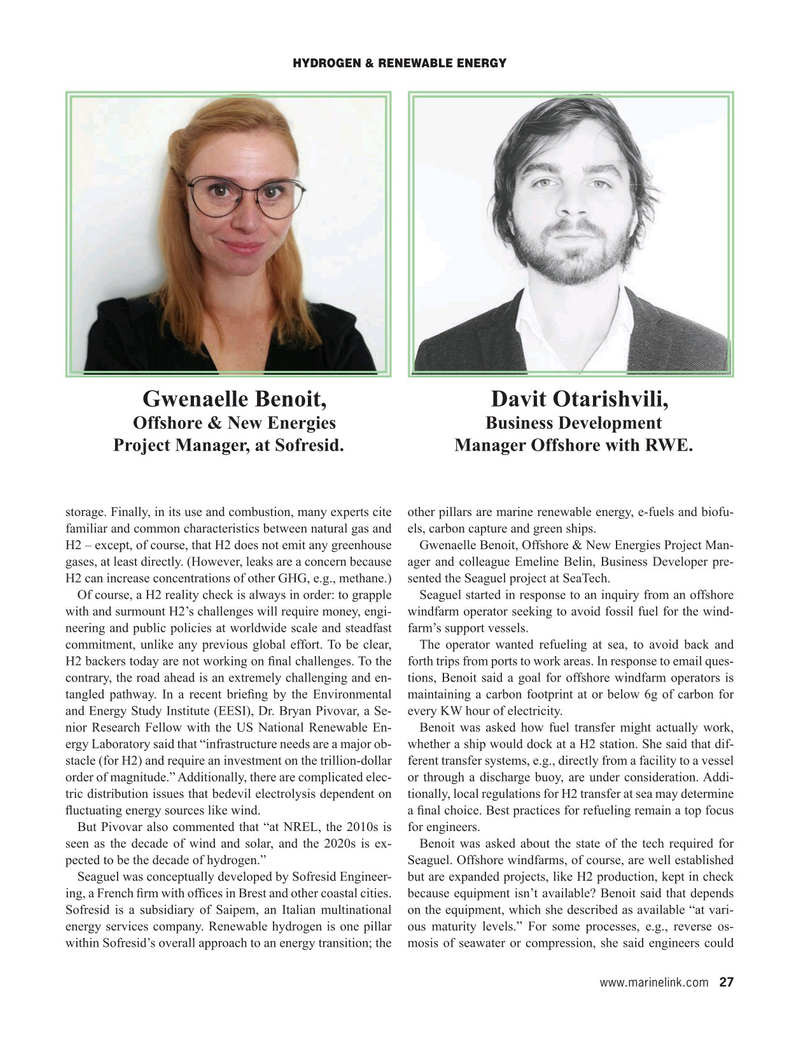
Page 27: of Maritime Reporter Magazine (February 2023)
Government Shipbuilding
Read this page in Pdf, Flash or Html5 edition of February 2023 Maritime Reporter Magazine
HYDROGEN & RENEWABLE ENERGY
Gwenaelle Benoit, Davit Otarishvili,
Offshore & New Energies Business Development
Project Manager, at Sofresid. Manager Offshore with RWE.
storage. Finally, in its use and combustion, many experts cite other pillars are marine renewable energy, e-fuels and biofu- familiar and common characteristics between natural gas and els, carbon capture and green ships.
H2 – except, of course, that H2 does not emit any greenhouse Gwenaelle Benoit, Offshore & New Energies Project Man- gases, at least directly. (However, leaks are a concern because ager and colleague Emeline Belin, Business Developer pre-
H2 can increase concentrations of other GHG, e.g., methane.) sented the Seaguel project at SeaTech.
Of course, a H2 reality check is always in order: to grapple Seaguel started in response to an inquiry from an offshore with and surmount H2’s challenges will require money, engi- windfarm operator seeking to avoid fossil fuel for the wind- neering and public policies at worldwide scale and steadfast farm’s support vessels. commitment, unlike any previous global effort. To be clear, The operator wanted refueling at sea, to avoid back and
H2 backers today are not working on ? nal challenges. To the forth trips from ports to work areas. In response to email ques- contrary, the road ahead is an extremely challenging and en- tions, Benoit said a goal for offshore windfarm operators is tangled pathway. In a recent brie? ng by the Environmental maintaining a carbon footprint at or below 6g of carbon for and Energy Study Institute (EESI), Dr. Bryan Pivovar, a Se- every KW hour of electricity.
nior Research Fellow with the US National Renewable En- Benoit was asked how fuel transfer might actually work, ergy Laboratory said that “infrastructure needs are a major ob- whether a ship would dock at a H2 station. She said that dif- stacle (for H2) and require an investment on the trillion-dollar ferent transfer systems, e.g., directly from a facility to a vessel order of magnitude.” Additionally, there are complicated elec- or through a discharge buoy, are under consideration. Addi- tric distribution issues that bedevil electrolysis dependent on tionally, local regulations for H2 transfer at sea may determine ? uctuating energy sources like wind. a ? nal choice. Best practices for refueling remain a top focus
But Pivovar also commented that “at NREL, the 2010s is for engineers.
seen as the decade of wind and solar, and the 2020s is ex- Benoit was asked about the state of the tech required for pected to be the decade of hydrogen.” Seaguel. Offshore windfarms, of course, are well established
Seaguel was conceptually developed by Sofresid Engineer- but are expanded projects, like H2 production, kept in check ing, a French ? rm with of? ces in Brest and other coastal cities. because equipment isn’t available? Benoit said that depends
Sofresid is a subsidiary of Saipem, an Italian multinational on the equipment, which she described as available “at vari- energy services company. Renewable hydrogen is one pillar ous maturity levels.” For some processes, e.g., reverse os- within Sofresid’s overall approach to an energy transition; the mosis of seawater or compression, she said engineers could www.marinelink.com 27
MR #2 (18-33).indd 27 2/1/2023 3:40:19 PM

 26
26

 28
28
